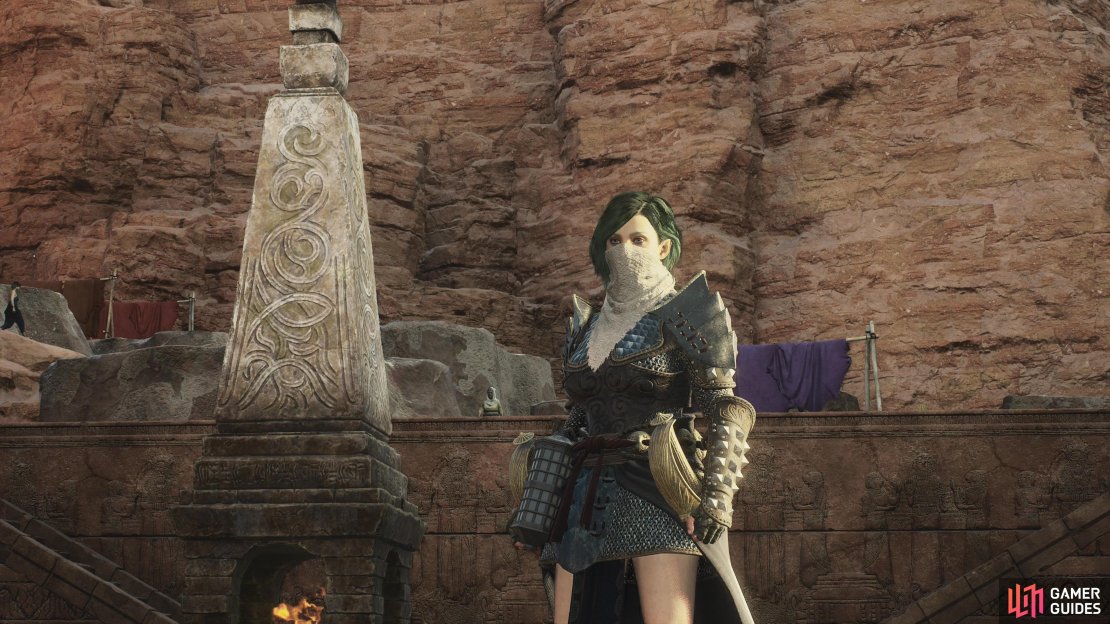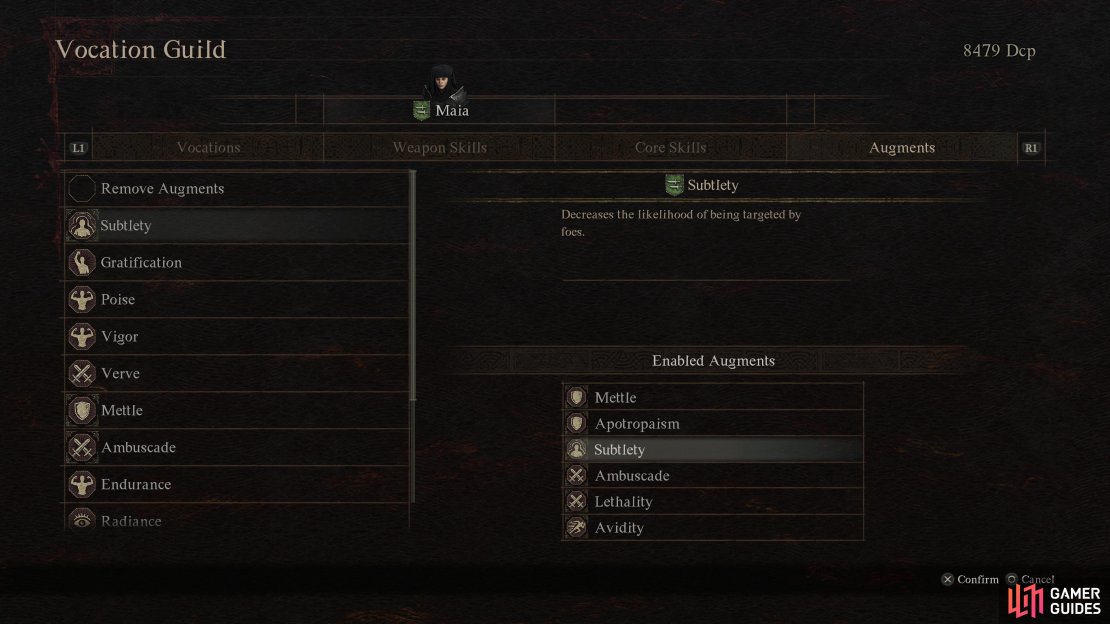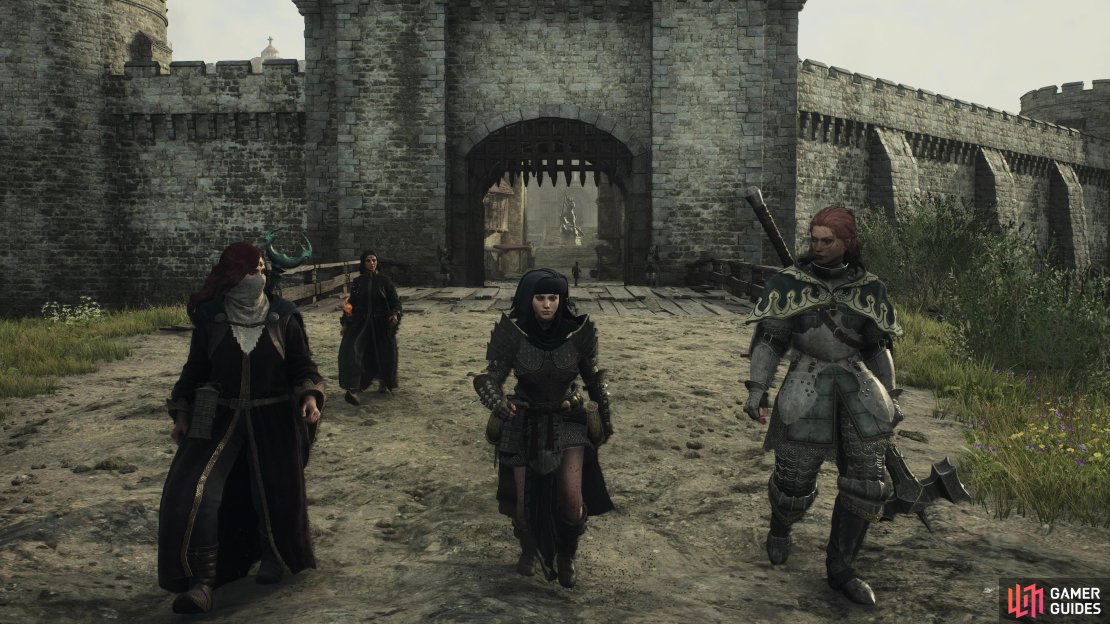If you’ve ever been in a fight with a monster, watching its life bar tick down slowly while your pawns fumbled around incompetently and wished there was a quick way to just deal with the problem yourself, the ![]() Thief might be the vocation for you! Agile, evasive, and capable of dealing massive damage to compromised enemies, the Thief is a solid choice for gamers who want a fast-paced, high-risk, high-reward combat experience in
Thief might be the vocation for you! Agile, evasive, and capable of dealing massive damage to compromised enemies, the Thief is a solid choice for gamers who want a fast-paced, high-risk, high-reward combat experience in ![]() Dragon’s Dogma 2. This page will discuss the Thief, including how to effectively use their skills, which skills and augments are the best, and which types of pawns pair well with them.
Dragon’s Dogma 2. This page will discuss the Thief, including how to effectively use their skills, which skills and augments are the best, and which types of pawns pair well with them.
The Thief in Dragons’ Dogma is a DPS-focused class who focuses on dodging to keep themselves alive.
Thief Build Overview¶
The Thief excels at two things - mobility and dealing a ton of damage to compromised enemies. That being the case, there’s not really much in the way of diverse “builds” for them, as you’re a speedy, close-quarters stabber who needs to dodge to stay alive either way. Some skills will make you more versatile and capable of dealing with lesser enemies, while others are better at throwing larger enemies off balance and punishing them. In the former case, other classes will do it better, and in the latter case… well, it depends on the big game you’re hunting. Large, living enemies like ![]() Cyclops,
Cyclops, ![]() Griffins and
Griffins and ![]() Drakes are susceptible to the ol’ grab-and-stab strategy, while enemies with unconventional constitutions which may be harder to grapple, like
Drakes are susceptible to the ol’ grab-and-stab strategy, while enemies with unconventional constitutions which may be harder to grapple, like ![]() Wights and
Wights and ![]() Dullahans, are best confronted with blitzing attacks that keep you mobile while dealing damage.
Dullahans, are best confronted with blitzing attacks that keep you mobile while dealing damage.
Should you play a Thief?¶
Damage mitigation is not something every class has - the Fighter can block with their trusty shield and the Mystic Spearhand can create magical barriers that absorb damage, but many other classes are limited to “walk out of the way before getting hit”. For some ARPG fans, that’s simply unacceptable, and the Thief answers with a dash, “![]() Swift Step”, which allows them to skitter out of the way from incoming aggression. While nowhere near as sturdy as a
Swift Step”, which allows them to skitter out of the way from incoming aggression. While nowhere near as sturdy as a ![]() Fighter, the Thief’s survivability is nonetheless enhanced by their evasiveness, but it’s a risk/reward proposition, as the Thief also has to remain in close-quarters combat to deal with most foes.
Fighter, the Thief’s survivability is nonetheless enhanced by their evasiveness, but it’s a risk/reward proposition, as the Thief also has to remain in close-quarters combat to deal with most foes.
Played proficiently, the Thief can dish out tremendous damage, in the meanwhile dashing around the battlefield and looking for (ideally building towards) openings in their foe’s defense. If you want to be directly in charge of bringing the biggest beasts in the game down personally and don’t mind being punished severely for your missteps, the Thief is the vocation for you.
In order to fully understand the Thief vocation in Dragon’s Dogma 2, check out the following sections to learn about their Skills, Attributes, Augments, and the best Pawns to pair them with:
(1 of 3) The Thief’s diverse list of skills includes Esnare/Implicate, which can pull enemies off balance - or even out of the skies!
Best Thief Weapon Skills¶
The Thief has a great number of weapon skills that are excellent… in specific scenarios. Outside of those specific use-cases, they’re considerably less impressive. This means there probably aren’t going to be many skills you use all the time (save out of laziness), and your willingness to visit campsites and swap out skills on the fly will determine how prepared you are to face the myriad challenges that await you. The few evergreen weapon skills for the Thief include:
-
 Helm Splitter/
Helm Splitter/ Skull Splitter: Jump into the air and turn into a spinning ball of daggers and death! It’s not quite as silly as in the original Dragon’s Dogma, but the core concept is the same, and it’s great for cutting up large targets and especially useful for enemies that aren’t easy to grapple. If you can get above a foe, even better, as the damage will increase significantly. Just be wary that it lasts for a good moment and you need to be sure to use it only when you know you’re not going to get hit afterwards - punishing enemy spellcasters or taking advantage of them immediately after using an attack that leaves them in a recovery state are ideal times.
Skull Splitter: Jump into the air and turn into a spinning ball of daggers and death! It’s not quite as silly as in the original Dragon’s Dogma, but the core concept is the same, and it’s great for cutting up large targets and especially useful for enemies that aren’t easy to grapple. If you can get above a foe, even better, as the damage will increase significantly. Just be wary that it lasts for a good moment and you need to be sure to use it only when you know you’re not going to get hit afterwards - punishing enemy spellcasters or taking advantage of them immediately after using an attack that leaves them in a recovery state are ideal times. -
 Concussive Step/
Concussive Step/ Concussive Leap: If you’re wondering what happened to everybody’s beloved Double Vault, this is it. It’s been promoted to a weapon skill and while it can cause small, nearby enemies to flinch, its main purpose is mobility, allowing you to effectively double jump. It uses a skill equip slot now and requires more button presses, so it’s generally more onerous than just having double jump was, but there are times when double jump is invaluable. Its utility can be fair in combat, but it’s primarily a traversal skill.
Concussive Leap: If you’re wondering what happened to everybody’s beloved Double Vault, this is it. It’s been promoted to a weapon skill and while it can cause small, nearby enemies to flinch, its main purpose is mobility, allowing you to effectively double jump. It uses a skill equip slot now and requires more button presses, so it’s generally more onerous than just having double jump was, but there are times when double jump is invaluable. Its utility can be fair in combat, but it’s primarily a traversal skill. -
 Ensnare/
Ensnare/ Implicate: Throw a grappling hook at an enemy and try to yank it off balance, which might seem merely fine on paper, but this skill is actually something of a test of your knowledge of Thief mechanics. Slashing enemies with daggers using the standard
Implicate: Throw a grappling hook at an enemy and try to yank it off balance, which might seem merely fine on paper, but this skill is actually something of a test of your knowledge of Thief mechanics. Slashing enemies with daggers using the standard attack was king in the original Dragon’s Dogma, but in Dragon’s Dogma 2 it’s more of a time-killer as you wear down enemies and set up more lethal assaults. That’s not to say using
 Carve is bad - it’s not, it’s the default - but
Carve is bad - it’s not, it’s the default - but  Twin Fangs is where the damage lives. Ensnare sets up enemies to be exploited, brutally, by Twin Fangs. Pull a
Twin Fangs is where the damage lives. Ensnare sets up enemies to be exploited, brutally, by Twin Fangs. Pull a  Goblin or
Goblin or  Harpy down to the ground and you’ll finish them off with one Twin Fangs finisher. Hardier foes like
Harpy down to the ground and you’ll finish them off with one Twin Fangs finisher. Hardier foes like  Hobgoblins can be pulled down to one knee, still sustaining massive damage. For large foes you’ll need to wait until they’re off balance for Ensnare to work, but the idea remains the same. Against weaker, smaller enemies this combined with Twin Fangs is a one-two punch that allows you to surgically murder your way through enemy ranks. Against larger enemies it’s something you pull out to down them when other attacks have sent them reeling.
Hobgoblins can be pulled down to one knee, still sustaining massive damage. For large foes you’ll need to wait until they’re off balance for Ensnare to work, but the idea remains the same. Against weaker, smaller enemies this combined with Twin Fangs is a one-two punch that allows you to surgically murder your way through enemy ranks. Against larger enemies it’s something you pull out to down them when other attacks have sent them reeling. -
 Gut and Run/
Gut and Run/ Draw and Quarter: As mentioned above, slashing used to be king. Climb up to an enemy’s weakspot and lay into them with Hundred Kiss. Lovely stuff! In Dragon’s Dogma 2, larger monsters are more likely to expel unwanted grapplers, meaning your grappling endeavors are best kept brief. Draw and Quarter is the answer to this newly created problem, as it deals massive damage and stagger when employed on an enemy’s weakspot and propels the Thief safely away from their victim, where you can often follow up with Hundred Kisses if they fall, or Ensnare if they’re knocked off balance. This skill may well end up being your primary means of dispatching Cyclops,
Draw and Quarter: As mentioned above, slashing used to be king. Climb up to an enemy’s weakspot and lay into them with Hundred Kiss. Lovely stuff! In Dragon’s Dogma 2, larger monsters are more likely to expel unwanted grapplers, meaning your grappling endeavors are best kept brief. Draw and Quarter is the answer to this newly created problem, as it deals massive damage and stagger when employed on an enemy’s weakspot and propels the Thief safely away from their victim, where you can often follow up with Hundred Kisses if they fall, or Ensnare if they’re knocked off balance. This skill may well end up being your primary means of dispatching Cyclops,  Ogres, Griffins, Drakes, and all other manner of larger beasties.
Ogres, Griffins, Drakes, and all other manner of larger beasties.
Those are arguably the “best” Thief skills, but there are situations where substitutions are worth considering:
-
 Biting Wind/
Biting Wind/ Cutting Wind: A high-mobility dash attack useful for dealing with mobs. Great against a host of weaker enemies, less useful against the bigs.
Cutting Wind: A high-mobility dash attack useful for dealing with mobs. Great against a host of weaker enemies, less useful against the bigs. -
 Enkindled Blades/
Enkindled Blades/ Ignited Blades: Useful any time you encounter an enemy weak to fire damage or resistant to physical damage, which isn’t as uncommon as you think. This skill allows you to enchant your blades with fire on a whim, making slimes and phantoms trivial. In a perfect world you won’t need this - you’ll get daggers that deal elemental damage and keep them handy, or one of your pawns will deal elemental damage. But we live in a world where pawns aren’t perfect executors of basic strategy, and this skill is in keeping with the Thief’s “screw it, I’ll do it myself!” flair.
Ignited Blades: Useful any time you encounter an enemy weak to fire damage or resistant to physical damage, which isn’t as uncommon as you think. This skill allows you to enchant your blades with fire on a whim, making slimes and phantoms trivial. In a perfect world you won’t need this - you’ll get daggers that deal elemental damage and keep them handy, or one of your pawns will deal elemental damage. But we live in a world where pawns aren’t perfect executors of basic strategy, and this skill is in keeping with the Thief’s “screw it, I’ll do it myself!” flair. -
 Powder Charge/
Powder Charge/ Powder Blast: Draw and Quarter is great for dealing damage to enemies and staggering them, but it only works if you hit an enemy’s weakspot. Implicate can leave enemies vulnerable, but larger enemies need to be off-balance for it to work. Powder Charge is the middle ground, an attack that deals minor damage but massive stagger, knocking most foes off balance - especially larger foes, if you place the charge directly on them. Doesn’t even need to target a weakspot. It’s an extra step, sure, but sometimes it’s too much of a hassle or risk to reach a weakspot, and a Powder Charge + Implicate combo should send most foes sprawling.
Powder Blast: Draw and Quarter is great for dealing damage to enemies and staggering them, but it only works if you hit an enemy’s weakspot. Implicate can leave enemies vulnerable, but larger enemies need to be off-balance for it to work. Powder Charge is the middle ground, an attack that deals minor damage but massive stagger, knocking most foes off balance - especially larger foes, if you place the charge directly on them. Doesn’t even need to target a weakspot. It’s an extra step, sure, but sometimes it’s too much of a hassle or risk to reach a weakspot, and a Powder Charge + Implicate combo should send most foes sprawling.
| Weapon Skill | Rank | Discipline Cost |
|---|---|---|
| Biting Wing | 1 | – |
| 4 | 1000 | |
| 1 | 200 | |
| 4 | 1000 | |
| 1 | 200 | |
| 5 | 1300 | |
| 2 | 300 | |
| 5 | 1300 | |
| 2 | 300 | |
| 6 \ 1600 | ||
| 3 | 450 | |
| 6 | 1600 | |
| 3 | 450 | |
| 7 | 2000 | |
| 4 | 700 | |
| 7 | 2000 | |
| 5 | 1100 | |
| 8 | 2500 | |
| 6 | 1800 | |
| 8 | 2500 | |
| 7 | 2500 | |
| 9 | 3000 |
| Core Skill | Rank | Discipline Cost |
|---|---|---|
| 1 | 150 | |
| 2 | 250 | |
| 3 | 400 | |
| 4 | 600 |
Attributes and Leveling¶
Your current vocation not only alters, to a small degree, your current stats, but slightly modifies the stats you get when you level up. Levels tend to have “themes” to them, where characters regardless of vocation may earn high Magick Defense that level. A Thief might earn +7 Magick Defense, a ![]() Mage +9, and a Fighter somewhat less. Simply put, the stat gain variations between vocations is a gradual thing, so if you want to massage your stats a certain way, that’ll mean an extended period of time playing as a different vocation.
Mage +9, and a Fighter somewhat less. Simply put, the stat gain variations between vocations is a gradual thing, so if you want to massage your stats a certain way, that’ll mean an extended period of time playing as a different vocation.
For their part, the Thief is very similar to the ![]() Archer inasmuch as they’re a jack of all trades, master of none. The Thief will generally get higher Strength and Stamina, but otherwise the two are very similar. Compared to a Fighter or
Archer inasmuch as they’re a jack of all trades, master of none. The Thief will generally get higher Strength and Stamina, but otherwise the two are very similar. Compared to a Fighter or ![]() Warrior, the Thief has lower Health, Strength, and Defense but higher Stamina, Magick, and Magick Defense, the latter of which is probably not going to matter much in light of the Fighter/Warrior’s higher Health. A more durable, physically potent Thief could be leveled as a Fighter or Warrior, but you’d have to decide if doing so is worth the time and effort.
Warrior, the Thief has lower Health, Strength, and Defense but higher Stamina, Magick, and Magick Defense, the latter of which is probably not going to matter much in light of the Fighter/Warrior’s higher Health. A more durable, physically potent Thief could be leveled as a Fighter or Warrior, but you’d have to decide if doing so is worth the time and effort.
Augments like Mettle and Apotropaism will help keep the Thief alive, while Ambuscade, Lethality, and Subtlety boost the Thief’s damage output.
Best Thief Augments in Dragon’s Dogma 2¶
The Thief is a close-range physical damage-dealer, and at a glance you might see one obvious augment for that type of character… and you’re right, but it’s probably not the augment you’re thinking of. Generally as a Thief you want to focus on reinforcing what you do best - dealing massive damage to compromised foes. A bit of survivability on the side won’t hurt, however, especially considering how much you can get with just a few augments.
| Augment | Rank | Discipline Cost |
|---|---|---|
| 2 | 300 | |
| 4 | 900 | |
| 6 | 1800 | |
| 8 | 3000 |
![]() Verve sounds like a no-brainer with its promise to “Augment your Strength”, but the number of gains you’ll get from this are fairly trivial.
Verve sounds like a no-brainer with its promise to “Augment your Strength”, but the number of gains you’ll get from this are fairly trivial. ![]() Subtlety, on the other hand, can help you shed aggro, which will help you stay alive provided you have pawns to provide alternative distractions. This is arguably the only augment worth having from the Thief list, and it could arguably be replaced with
Subtlety, on the other hand, can help you shed aggro, which will help you stay alive provided you have pawns to provide alternative distractions. This is arguably the only augment worth having from the Thief list, and it could arguably be replaced with ![]() Vigor in fights where you plan to spend a lot of time grappling foes.
Vigor in fights where you plan to spend a lot of time grappling foes.
The Archer, on the other hand, has a lot of great augments for the Thief. ![]() Ambuscade will “increase damage by your attacks when targets are not in battle stance”, which presumably counts staggered and downed foes - the Thief’s bread and butter.
Ambuscade will “increase damage by your attacks when targets are not in battle stance”, which presumably counts staggered and downed foes - the Thief’s bread and butter. ![]() Lethality is even better, as it “increases damage dealt when striking a target’s vitals”, and since the Thief ideally wants to grab a foe and use skills like Draw and Quarter on their weakspots, this is a solid damage boost, as well. Finally there’s
Lethality is even better, as it “increases damage dealt when striking a target’s vitals”, and since the Thief ideally wants to grab a foe and use skills like Draw and Quarter on their weakspots, this is a solid damage boost, as well. Finally there’s ![]() Avidity, which will allow you to climb faster while grappling, which makes it easier to reach a foe’s weakspot before they can dislodge you.
Avidity, which will allow you to climb faster while grappling, which makes it easier to reach a foe’s weakspot before they can dislodge you.
In addition to the Thief and Archer’s augments, grabbing ![]() Mettle as a Fighter and
Mettle as a Fighter and ![]() Apotropaism as a Mage to greatly boost your Defense and Magick Defense are also fine moves. The goal is to not get hit, of course, but at some point, reality needs to creep in this build and these skills will make it more likely that you won’t get one-shotted, because odds are you’re not going to play a perfect game.
Apotropaism as a Mage to greatly boost your Defense and Magick Defense are also fine moves. The goal is to not get hit, of course, but at some point, reality needs to creep in this build and these skills will make it more likely that you won’t get one-shotted, because odds are you’re not going to play a perfect game.
| Augment | Description | How to get it |
|---|---|---|
| Increases damage dealt by your attacks when targets are not in battle stance | Rank up the |
|
| Augments your Magick Defense | Rank up the |
|
| Enables you to clamber up cliffs and scale foes and other surfaces more quickly | Rank up the |
|
| Increases damage dealt when striking a target’s vitals | Rank up the |
|
| Augments your physical Defense | Rank up the |
|
| Decreases the likelihood of being targeted by foes | Rank up the |
A Thief Arisen is best accompanied by a Mage (healing/support), Sorcerer (DPS), and Warrior (DPS/tank).
Best Pawns with a Thief Arisen¶
A Thief Arisen should, in an ideal world, be your party’s DPS… and a bit of a glass cannon. Sure, you won’t be the best at clearing up trash mobs, but the grab-and-stab works on most foes in the game, you can have pawns keeping the goblins and harpies at bay while you cook the bigger fish. That said, you need support to help keep the aggro off you and to cover things your build can’t do - having a Mage for boons and healing is an obvious move, and bringing a ![]() Sorcerer will provide a secondary DPS/glass cannon that can also deal with enemies who are resistant to physical damage.
Sorcerer will provide a secondary DPS/glass cannon that can also deal with enemies who are resistant to physical damage.
This leaves us with a DPS, support/healer, and another DPS, which makes our final role obvious: we need a tank. When it comes to a tanky pawn, there are only two good choices, the Fighter and the Warrior, and while the Fighter is a better tank due to their shield and higher overall Defense, the gulf isn’t vast. In addition to drawing aggro and tanking hits for the rest of your party, the Warrior also tends to inflict a great deal of stagger with their massive weapons, which plays into the Thief’s strengths very well, making them the preferred option. Just make sure you get a Mage with the “Kindhearted” inclination and a Sorcerer and Warrior with the “Straightforward” inclinations to ensure your healer heals and the other two focus on offense.







No Comments